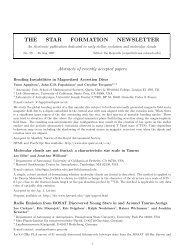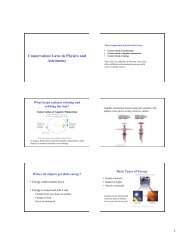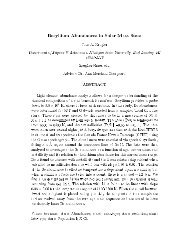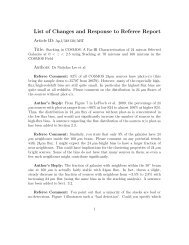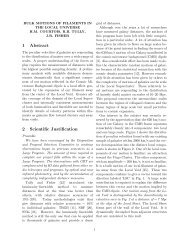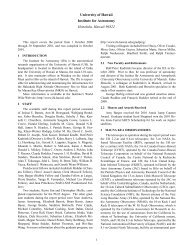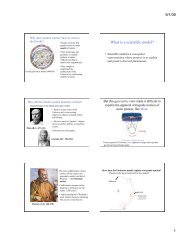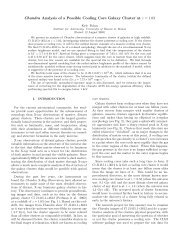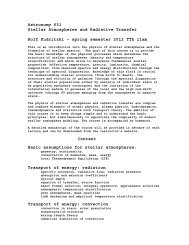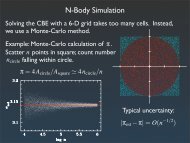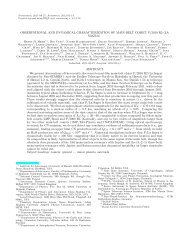Using Fe and Mg in olivine as an indicator of asteroidal ...
Using Fe and Mg in olivine as an indicator of asteroidal ...
Using Fe and Mg in olivine as an indicator of asteroidal ...
Create successful ePaper yourself
Turn your PDF publications into a flip-book with our unique Google optimized e-Paper software.
<strong>Us<strong>in</strong>g</strong> <strong>Fe</strong> <strong><strong>an</strong>d</strong> <strong>Mg</strong> <strong>in</strong> oliv<strong>in</strong>e <strong>as</strong> <strong>an</strong> <strong>in</strong>dicator <strong>of</strong> <strong>as</strong>teroidal hydrothermal<br />
alteration.<br />
Anne Sweet<br />
Macalester College<br />
St. Paul MN 55105<br />
Lysa Chizmadia<br />
University <strong>of</strong> Hawaii<br />
Honolulu, HI 96822<br />
Abstract<br />
Amoeboid Oliv<strong>in</strong>e Aggregates (AOAs) found <strong>in</strong> CO3 meteorites are sensitive<br />
<strong>in</strong>dicators <strong>of</strong> parent body alteration. As water encounters these objects on the parent body<br />
<strong>as</strong>teroid, the <strong>Mg</strong>-rich oliv<strong>in</strong>e, forsterite (<strong>Mg</strong>2SiO4), is replaced with <strong>Fe</strong>-rich oliv<strong>in</strong>e,<br />
creat<strong>in</strong>g fayalite (<strong>Fe</strong>2SiO4). The calculation <strong>of</strong> the <strong>Fe</strong>/<strong>Mg</strong> ratio <strong>of</strong> the, along with a visual<br />
exam<strong>in</strong>ation <strong>of</strong> the ferro<strong>an</strong> ve<strong>in</strong>s <strong><strong>an</strong>d</strong> diffusive halos <strong>in</strong> these features, allows for a<br />
cl<strong>as</strong>sification <strong>of</strong> the petrologic subtype (3.0-3.8) <strong>of</strong> the meteorite. By us<strong>in</strong>g a sc<strong>an</strong>n<strong>in</strong>g<br />
electron microscope (SEM) for meteorite mapp<strong>in</strong>g, feature identification, <strong><strong>an</strong>d</strong> element<br />
mapp<strong>in</strong>g, <strong>as</strong> well <strong>as</strong> <strong>an</strong> electron microprobe (EMP) for accurate elemental abund<strong>an</strong>ce<br />
calculation, we were able to accomplish this cl<strong>as</strong>sification. In this work we present the<br />
subtype cl<strong>as</strong>sification <strong>of</strong> six new meteorites along with the <strong>an</strong>alysis <strong>of</strong> two previously<br />
studied meteorites <strong>as</strong> st<strong><strong>an</strong>d</strong>ards.<br />
Introduction<br />
Chondritic meteorites act <strong>as</strong> time capsules preserved from the formation <strong>of</strong> the solar<br />
system, reta<strong>in</strong><strong>in</strong>g <strong>in</strong>formation about the hydrothermal processes present dur<strong>in</strong>g that time.<br />
These chondrites never experienced melt<strong>in</strong>g, <strong>as</strong> evidenced by the presence <strong>of</strong> <strong>Fe</strong>Ni alloys<br />
<strong><strong>an</strong>d</strong> nebular objects (e.g. chondrules <strong><strong>an</strong>d</strong> Calcium-Alum<strong>in</strong>um Inclusions (CAIs))<br />
throughout the meteorites. Chondrites have a bulk composition that is very similar to that<br />
<strong>of</strong> the sun, re<strong>in</strong>forc<strong>in</strong>g their primitive natures. Radiocarbon dat<strong>in</strong>g us<strong>in</strong>g the long-lived<br />
radioisotopes (e.g. Pb-Pb, U-Th, Sm-Nd, Rb-Sr) c<strong>an</strong> provide us with early <strong>in</strong>formation<br />
about the solar system. For example, the dat<strong>in</strong>g <strong>of</strong> CAIs show that these objects were<br />
formed 4.56 Ga <strong><strong>an</strong>d</strong> are the oldest solids to have formed <strong>in</strong> our solar system.<br />
Although these meteorites are not severely metamorphosed, they have undergone<br />
some alteration due to the presence <strong>of</strong> water <strong><strong>an</strong>d</strong> heat. 53 Cr- 53 Mn <strong><strong>an</strong>d</strong> 129 I 129 Xe dat<strong>in</strong>g <strong>of</strong><br />
secondary carbonates show that aqueous alteration occurred 1-4 Ma after the formation <strong>of</strong><br />
CAIs. 1 Underst<strong><strong>an</strong>d</strong><strong>in</strong>g this alteration sequence allows for a better underst<strong><strong>an</strong>d</strong><strong>in</strong>g <strong>of</strong> how<br />
the heat <strong><strong>an</strong>d</strong> water were distributed on the parent body <strong>as</strong>teroid. Currently there are two<br />
ma<strong>in</strong> models detail<strong>in</strong>g the alteration patterns, the onion sk<strong>in</strong> model, <strong><strong>an</strong>d</strong> the plum pudd<strong>in</strong>g<br />
model (Figure 1).<br />
1
Fig. 1: Schematic show<strong>in</strong>g the two preferred models for <strong>as</strong>teroidal alteration patterns. The first, the onion<br />
sk<strong>in</strong> model shows all the alteration occurr<strong>in</strong>g <strong>in</strong> a layered process, with the most alteration occurr<strong>in</strong>g <strong>in</strong> the<br />
center, where<strong>as</strong> the second, the plum-pudd<strong>in</strong>g model, shows several different alteration centers scattered<br />
throughout the parent body.<br />
Although it is not currently known which model accurately represents the alteration<br />
on the parent body, the study <strong><strong>an</strong>d</strong> cl<strong>as</strong>sification <strong>of</strong> the meteorites <strong>in</strong>to subtypes will help<br />
to create a statistical b<strong>as</strong>is on which conclusions c<strong>an</strong> be made.<br />
Background<br />
Meteorites are divided <strong>in</strong>to several different categories b<strong>as</strong>ed on composition. The<br />
primary dist<strong>in</strong>ction is made on the b<strong>as</strong>is <strong>of</strong> the presence <strong>of</strong> chondrules. Chondrules are<br />
mm-sized igneous spherules surrounded by matrix. Matrix is the 1-10 µm f<strong>in</strong>e-gra<strong>in</strong>ed<br />
material surround<strong>in</strong>g the larger objects <strong>in</strong> a meteorite (Figure 2).<br />
Fig 2: A collection <strong>of</strong> various back-scattered electron images show<strong>in</strong>g examples <strong>of</strong> the different features<br />
2
found <strong>in</strong> meteorites. Figures 2a,b,d,e, <strong><strong>an</strong>d</strong> f show a chondrule surrounded by f<strong>in</strong>e-gra<strong>in</strong>ed matrix. Figure 2a<br />
shows barred oliv<strong>in</strong>e with<strong>in</strong> a chondrule encapsulated with<strong>in</strong> <strong>an</strong>other chondrule <strong>in</strong> QUE97416, Figure 2b<br />
shows barred oliv<strong>in</strong>e with<strong>in</strong> a chondrule <strong>in</strong> L<strong>an</strong>cé, Figure 2c shows magnetite <strong>in</strong> Tagish Lake, Figure 2d<br />
shows barred oliv<strong>in</strong>e with<strong>in</strong> a chondrule <strong>in</strong> MET00711,5 Figure 2e shows a metal gra<strong>in</strong> with<strong>in</strong> a chondrule<br />
<strong>in</strong> L<strong>an</strong>cé <strong><strong>an</strong>d</strong> f<strong>in</strong>ally, Figure 2f shows a <strong>in</strong>terest<strong>in</strong>g barred oliv<strong>in</strong>e with<strong>in</strong> a chondrule with<strong>in</strong> ALH83108.<br />
The Achondrites have undergone a melt<strong>in</strong>g event, destroy<strong>in</strong>g all <strong>in</strong>formation about<br />
their orig<strong>in</strong>al formation, <strong>in</strong>clud<strong>in</strong>g <strong>an</strong>y pre-exist<strong>in</strong>g chondrules. The Chondrites still reta<strong>in</strong><br />
their nebular objects (e.g. chondrules, CAIs, matrix) <strong><strong>an</strong>d</strong> therefore much <strong>of</strong> the<br />
<strong>in</strong>formation about their formation. 1 Because the chondrites are the most common type <strong>of</strong><br />
meteorite, the study <strong>of</strong> these make statistical conclusions useful <strong><strong>an</strong>d</strong> relev<strong>an</strong>t.<br />
Chondrites c<strong>an</strong> be further divided b<strong>as</strong>ed on their Ca/Si <strong><strong>an</strong>d</strong> Al/Si ratios <strong><strong>an</strong>d</strong> amount<br />
<strong>of</strong> matrix. Both calcium <strong><strong>an</strong>d</strong> alum<strong>in</strong>um have high condensation temperatures <strong><strong>an</strong>d</strong> are<br />
therefore the first to condense <strong>in</strong>to solid material. These groups <strong>of</strong> chondrites are the<br />
enstatite chondrites, ord<strong>in</strong>ary chondrites <strong><strong>an</strong>d</strong> carbonaceous chondrites. 1 This work<br />
focuses on the carbonaceous chondrites, which have the highest Ca/Si ratio (>6 at%) <strong><strong>an</strong>d</strong><br />
Al/Si ratio (>8 at%) <strong>of</strong> the chondrites, <strong>in</strong> addition to the highest amount <strong>of</strong> matrix by<br />
volume well (>30 vol%). 2 3 Their matrix also conta<strong>in</strong>s carbon <strong>in</strong> the form <strong>of</strong> carbonate<br />
<strong><strong>an</strong>d</strong>/or org<strong>an</strong>ic compounds, <strong>as</strong> well <strong>as</strong> the presence <strong>of</strong> water <strong>in</strong> hydrous m<strong>in</strong>erals mak<strong>in</strong>g<br />
them <strong>in</strong>terest<strong>in</strong>g to study when consider<strong>in</strong>g them <strong>as</strong> a vehicle for facilitat<strong>in</strong>g life on Earth.<br />
The carbonaceous chondrites do show a spectrum <strong>of</strong> alteration levels <strong><strong>an</strong>d</strong> are<br />
therefore cl<strong>as</strong>sified with a number between 1 <strong><strong>an</strong>d</strong> 7 to reflect this alteration. The<br />
meteorites that are m<strong>in</strong>imally altered are <strong>as</strong>signed the number 3 <strong><strong>an</strong>d</strong> are cl<strong>as</strong>sified<br />
primarily by the opacity <strong>of</strong> the matrix, def<strong>in</strong>ition <strong>of</strong> the chondrules, <strong><strong>an</strong>d</strong> levels <strong>of</strong> me<strong>an</strong><br />
compositional deviations <strong>of</strong> pyroxene <strong><strong>an</strong>d</strong> oliv<strong>in</strong>e. A type <strong>of</strong> 1-2 <strong>in</strong>dicate contact with<br />
water (a 1 be<strong>in</strong>g more aqueous altered th<strong>an</strong> a 2) <strong><strong>an</strong>d</strong> are cl<strong>as</strong>sified by a decre<strong>as</strong>e <strong>in</strong> the<br />
deviation <strong>of</strong> me<strong>an</strong> composition <strong>in</strong> pyroxene <strong><strong>an</strong>d</strong> oliv<strong>in</strong>e, <strong>an</strong> <strong>in</strong>cre<strong>as</strong>e <strong>in</strong> the f<strong>in</strong>e-gra<strong>in</strong>ed<br />
nature <strong>of</strong> the matrix, <strong><strong>an</strong>d</strong> <strong>in</strong>cre<strong>as</strong>e <strong>in</strong> the bulk carbon content. Types from 4-7 <strong>in</strong>dicate<br />
heat<strong>in</strong>g events which are characterized by the recrystalization <strong>of</strong> the matrix, the blurr<strong>in</strong>g<br />
<strong>of</strong> the chondrule edges <strong><strong>an</strong>d</strong> the me<strong>an</strong> deviation <strong>of</strong> compositional variation <strong>in</strong> oliv<strong>in</strong>e <strong><strong>an</strong>d</strong><br />
pyroxene decre<strong>as</strong><strong>in</strong>g to zero. 2 3<br />
The carbonaceous chondrites c<strong>an</strong> be further divided <strong>in</strong>to 7 categories (CI, CM, CB,<br />
CR, CO, CV, CK <strong><strong>an</strong>d</strong> CH) 4 b<strong>as</strong>ed on their bulk compositions, oxygen isotopes, chondrule<br />
abund<strong>an</strong>ces <strong><strong>an</strong>d</strong> refractory element abund<strong>an</strong>ces 1 . The CO chondrites studied <strong>in</strong> this work<br />
are all type 3 <strong><strong>an</strong>d</strong> therefore are <strong>of</strong>ten referred to <strong>as</strong> CO3s. The CO3 chondrites show a<br />
r<strong>an</strong>ge <strong>in</strong> amount <strong>of</strong> hydrothermal alteration <strong><strong>an</strong>d</strong> have been <strong>as</strong>signed subtypes on the b<strong>as</strong>is<br />
<strong>of</strong> this level <strong>of</strong> alteration <strong>in</strong> each meteorite.<br />
Orig<strong>in</strong>ally, CO3 chondrites were broken <strong>in</strong>to three groups, I, II <strong><strong>an</strong>d</strong> III, on the b<strong>as</strong>is<br />
<strong>of</strong> the <strong>Fe</strong> content <strong>of</strong> oliv<strong>in</strong>e <strong><strong>an</strong>d</strong> pyroxene gra<strong>in</strong>s 5 , then thermolum<strong>in</strong>escence w<strong>as</strong> used to<br />
correlate the alteration levels with those seen <strong>in</strong> the ord<strong>in</strong>ary chondrites 6 . The subtypes<br />
r<strong>an</strong>ge from 3.0-3.8 depend<strong>in</strong>g on the level <strong>of</strong> alteration, 3.0 be<strong>in</strong>g the le<strong>as</strong>t altered <strong><strong>an</strong>d</strong><br />
3.8 be<strong>in</strong>g the most altered. Later, the progressive <strong>Fe</strong> enrichment <strong>of</strong> oliv<strong>in</strong>e <strong>in</strong> chondrules<br />
w<strong>as</strong> shown to be less sensitive to terrestrial alteration 7 . The current st<strong><strong>an</strong>d</strong>ard is the<br />
me<strong>as</strong>urement <strong>of</strong> <strong>Fe</strong> enrichment <strong>of</strong> oliv<strong>in</strong>e <strong>in</strong> amoeboid oliv<strong>in</strong>e aggregates (also known <strong>as</strong><br />
amoeboid oliv<strong>in</strong>e <strong>in</strong>clusions), which are composed <strong>of</strong> smaller crystals 8 . The cl<strong>as</strong>sification<br />
<strong>of</strong> the seven CO3 chondrites (ALH83108, A-882094, MET00694, MET00711,<br />
MET00737, QUE97416, Y-82094) <strong>in</strong>to their petrologic subtypes is the ma<strong>in</strong> goal <strong>of</strong> this<br />
3
project.<br />
Amoeboid Oliv<strong>in</strong>e Aggregates (AOAs)<br />
To determ<strong>in</strong>e the subtypes <strong>of</strong> these meteorites <strong>in</strong> this work, we use Amoeboid<br />
Oliv<strong>in</strong>e Aggregates (AOAs) <strong>as</strong> a b<strong>as</strong>is <strong>of</strong> hydrothermal alteration. These are identified<br />
b<strong>as</strong>ed on their irregular shape <strong><strong>an</strong>d</strong> composition <strong>of</strong> mostly oliv<strong>in</strong>e, some Anorthite<br />
(CaAl2Si2O8) <strong><strong>an</strong>d</strong> Diopside (Ca<strong>Mg</strong>Si2O6), <strong>as</strong> well <strong>as</strong> the occ<strong>as</strong>ional presence <strong>of</strong> sp<strong>in</strong>el<br />
(<strong>Mg</strong>Al2O4). These objects are particularly useful to consider when cl<strong>as</strong>sify<strong>in</strong>g alteration<br />
because they are composed <strong>of</strong> small gra<strong>in</strong>s (5-10µm) <strong><strong>an</strong>d</strong> thus the high surface area to<br />
volume ratio <strong>of</strong> the oliv<strong>in</strong>e crystals make them extremely sensitive to hydrothermal<br />
alteration. As water percolates through the meteorites, <strong>Fe</strong> is dissolved <strong>in</strong>to the fluid, most<br />
likely from the <strong>Fe</strong>Ni metal gra<strong>in</strong>s, <strong>Fe</strong>-rich oliv<strong>in</strong>e gra<strong>in</strong>s <strong><strong>an</strong>d</strong> <strong>Fe</strong>-bear<strong>in</strong>g amorphous<br />
materials <strong>in</strong> the f<strong>in</strong>e-gra<strong>in</strong>ed matrix. Water moves along the oliv<strong>in</strong>e crystal boundaries<br />
<strong><strong>an</strong>d</strong> cracks, deposit<strong>in</strong>g a new layer <strong>of</strong> <strong>Fe</strong>-rich oliv<strong>in</strong>e. This creates a turtle shell-like<br />
pattern <strong>of</strong> <strong>Mg</strong>-rich oliv<strong>in</strong>e surrounded by ferro<strong>an</strong> oliv<strong>in</strong>e ve<strong>in</strong>s. With cont<strong>in</strong>ued contact<br />
with water, the ve<strong>in</strong>s thicken <strong><strong>an</strong>d</strong> the temperature beg<strong>in</strong>s to rise. Eventually diffusion<br />
beg<strong>in</strong>s <strong>an</strong> import<strong>an</strong>t process creat<strong>in</strong>g diffusive halos, cont<strong>in</strong>u<strong>in</strong>g the replacement <strong>of</strong> <strong>Mg</strong>rich<br />
oliv<strong>in</strong>e with <strong>Fe</strong>-rich oliv<strong>in</strong>e. At the f<strong>in</strong>al subtype, 3.8, all <strong>of</strong> the <strong>Mg</strong>-rich oliv<strong>in</strong>e h<strong>as</strong><br />
been consumed <strong><strong>an</strong>d</strong> the <strong>Fe</strong> content <strong>of</strong> the oliv<strong>in</strong>e is similar to that <strong>of</strong> the surround<strong>in</strong>g<br />
matrix, <strong>in</strong>dicat<strong>in</strong>g equilibration.<br />
By <strong>an</strong>alyz<strong>in</strong>g the composition <strong>of</strong> oliv<strong>in</strong>e <strong>in</strong> these AOAs <strong><strong>an</strong>d</strong> calculat<strong>in</strong>g the ratio <strong>of</strong><br />
forsterite to fayalite, <strong>as</strong> well <strong>as</strong> exam<strong>in</strong><strong>in</strong>g the thicknesses <strong>of</strong> the ferro<strong>an</strong> ve<strong>in</strong>s <strong><strong>an</strong>d</strong><br />
diffusive haloes, it becomes possible to cl<strong>as</strong>sify the petrologic subtype <strong>of</strong> each meteorite<br />
by us<strong>in</strong>g the methods outl<strong>in</strong>ed by Chizmadia et al. (2002). (Figure 3 <strong><strong>an</strong>d</strong> 4)<br />
Fig 3: A table from Chizmadia et. al. (2002) show<strong>in</strong>g the qu<strong>an</strong>tification <strong>of</strong> the ch<strong>an</strong>ges <strong>in</strong> ve<strong>in</strong> size <strong><strong>an</strong>d</strong><br />
diffusive halo size with <strong>in</strong>cre<strong>as</strong><strong>in</strong>g alteration. With more alteration, more <strong>Mg</strong> is replaced with <strong>Fe</strong>,<br />
<strong>in</strong>cre<strong>as</strong><strong>in</strong>g the size <strong>of</strong> ve<strong>in</strong>s <strong><strong>an</strong>d</strong> diffusive halos.<br />
4
Fig 4: Histograms from Chizmadia et. al. (2002) show<strong>in</strong>g the ch<strong>an</strong>ges <strong>in</strong> the ratio <strong>of</strong> <strong>Mg</strong>-rich oliv<strong>in</strong>e to <strong>Fe</strong>rich<br />
oliv<strong>in</strong>e <strong>as</strong> a function <strong>of</strong> <strong>an</strong>alysis on the electron microprobe. An unaltered meteorite (3.0) conta<strong>in</strong>s<br />
oliv<strong>in</strong>e completely <strong>in</strong> the <strong>Mg</strong> form, where<strong>as</strong> a completely altered meteorite (3.8) conta<strong>in</strong>s only <strong>Fe</strong> oliv<strong>in</strong>e.<br />
The stages <strong>in</strong> between illustrate the replacement <strong>of</strong> forsterite with fayalite.<br />
Although the focus <strong>of</strong> this work is on the oliv<strong>in</strong>e present <strong>in</strong> these features, the<br />
secondary m<strong>in</strong>erals (<strong>an</strong>orthite, diopside <strong><strong>an</strong>d</strong> sp<strong>in</strong>el) are also <strong>in</strong>terest<strong>in</strong>g to exam<strong>in</strong>e,<br />
particularly through the use <strong>of</strong> x-ray element mapp<strong>in</strong>g to consider the affect <strong>of</strong> alteration<br />
on other elements.<br />
Analytic Methods<br />
N<strong>in</strong>e carbon-coated, polished meteorite th<strong>in</strong> sections were selected for <strong>an</strong>alysis:<br />
ALH83108, A-882094, L<strong>an</strong>cé, MET00694:5, MET00711:5, MET00737:11,<br />
QUE97416:7, Y-82050 <strong><strong>an</strong>d</strong> Y-82094. In order to accurately <strong>an</strong>alyze these features, maps<br />
were made <strong>of</strong> each th<strong>in</strong> section us<strong>in</strong>g the JEOL JSM5900 LV sc<strong>an</strong>n<strong>in</strong>g electron<br />
microscope (SEM) at the Hawaii Institute for Geophysics <strong><strong>an</strong>d</strong> Pl<strong>an</strong>etology (HIGP) at the<br />
University <strong>of</strong> Hawaii (UH). These maps were created by <strong>as</strong>sembl<strong>in</strong>g m<strong>an</strong>y <strong>in</strong>dividual<br />
back-scattered electron (BSE) images <strong>of</strong> the meteorite taken at a magnification<br />
<strong>of</strong> 65x, a voltage <strong>of</strong> 15kV <strong><strong>an</strong>d</strong> with a beam spot size <strong>of</strong> 56. Back-scattered electrons are<br />
those that come from the collimated beam <strong>of</strong> electrons <strong><strong>an</strong>d</strong> bounce <strong>of</strong>f the sample <strong><strong>an</strong>d</strong> are<br />
collected by a detector. The number <strong>of</strong> counts is directly proportional to the atomic<br />
number <strong>of</strong> the object <strong>in</strong> the sample so therefore the whitest spots on the image are the<br />
heaviest elements. These <strong>in</strong>dividual images were then <strong>as</strong>sembled us<strong>in</strong>g Photoshop to<br />
create the map. (Figure 5)<br />
5
Fig 5: An example <strong>of</strong> <strong>an</strong> <strong>as</strong>sembled meteorite map. This is the meteorite Y82094 th<strong>in</strong> section BSE map.<br />
This type <strong>of</strong> mapp<strong>in</strong>g w<strong>as</strong> accomplished for all meteorites <strong>in</strong> the study.<br />
Once maps were made, five AOAs <strong>in</strong> each meteorite were selected <strong><strong>an</strong>d</strong> imaged<br />
us<strong>in</strong>g the SEM to prepare for <strong>an</strong>alysis on the microprobe. When relev<strong>an</strong>t, <strong>in</strong>terest<strong>in</strong>g<br />
features <strong>in</strong> the AOAs were selected for element mapp<strong>in</strong>g.<br />
Element mapp<strong>in</strong>g w<strong>as</strong> done for 15 elements (C, O, Na, <strong>Mg</strong>, Al, Si, P, S, K, Ca, Ti,<br />
Cr, Mn, <strong>Fe</strong>, Ni). These maps are comprised <strong>of</strong> x-ray detections. These x-rays are emitted<br />
when the electron beam <strong>in</strong>teracts with the sample, knocks <strong>an</strong> electron out <strong>of</strong> its shell, <strong><strong>an</strong>d</strong><br />
the tr<strong>an</strong>sition that occurs emits a photon whose energy corresponds to a specific atomic<br />
tr<strong>an</strong>sition (for this <strong>an</strong>alysis, these tr<strong>an</strong>sitions are the K series). The detector collects the<br />
photons from each tr<strong>an</strong>sition for the selected elements <strong><strong>an</strong>d</strong> a map <strong>of</strong> the locations <strong>of</strong> each<br />
element is made.<br />
F<strong>in</strong>ally, <strong>an</strong> electron microprobe (EMP) w<strong>as</strong> used gather qu<strong>an</strong>titative compositional<br />
data <strong>of</strong> the oliv<strong>in</strong>e <strong>in</strong>side the AOAs. These <strong>an</strong>alyses were done us<strong>in</strong>g Cameca SX50 EMP<br />
for 14 elements (Si, <strong>Mg</strong>, <strong>Fe</strong>, Mn, Al, Ca, Ti, Cr, S, Na, K, P, Ni, O) us<strong>in</strong>g 4 crystal<br />
spectrometers, natural m<strong>in</strong>eral <strong><strong>an</strong>d</strong> synthetic st<strong><strong>an</strong>d</strong>ards, count<strong>in</strong>g times, PAP corrections,<br />
a beam current <strong>of</strong> 30nA <strong><strong>an</strong>d</strong> <strong>an</strong> acceleration voltage <strong>of</strong> 30kV. The EMP also detects the<br />
x-rays emitted from the <strong>in</strong>teraction between the beam <strong><strong>an</strong>d</strong> the sample but <strong>in</strong> this c<strong>as</strong>e the<br />
crystal spectrometers are diffract<strong>in</strong>g very specific wavelengths <strong>of</strong> energy that correspond<br />
to various atomic tr<strong>an</strong>sitions <strong><strong>an</strong>d</strong> the detectors keep count <strong>of</strong> each detection. Three AOAs<br />
per meteorite were selected for <strong>an</strong>alysis. When applicable, both <strong>Mg</strong> <strong><strong>an</strong>d</strong> <strong>Fe</strong> rich are<strong>as</strong><br />
were <strong>an</strong>alyzed. However, the BSE feature <strong>of</strong> the probe w<strong>as</strong> down dur<strong>in</strong>g the <strong>an</strong>alysis so<br />
spots were found us<strong>in</strong>g the optical <strong><strong>an</strong>d</strong> tr<strong>an</strong>smitted microscope features <strong><strong>an</strong>d</strong> therefore<br />
f<strong>in</strong>d<strong>in</strong>g the location <strong>of</strong> these features were difficult <strong><strong>an</strong>d</strong> the risk <strong>of</strong> overlapp<strong>in</strong>g with one<br />
<strong>of</strong> the other ph<strong>as</strong>es (ex: Anorthite or Diopside) when tak<strong>in</strong>g data w<strong>as</strong> <strong>in</strong>cre<strong>as</strong>ed. In<br />
addition, the probe w<strong>as</strong> down for some <strong>of</strong> the scheduled <strong>an</strong>alysis periods <strong><strong>an</strong>d</strong> therefore<br />
not all meteorites were able to be <strong>an</strong>alyzed.<br />
6
Analysis<br />
Microprobe data w<strong>as</strong> sorted us<strong>in</strong>g Excel. From the EMP, we sorted the data <strong>in</strong>to 3<br />
different tables, element%, atomic% <strong><strong>an</strong>d</strong> oxide%. First, each table w<strong>as</strong> sorted accord<strong>in</strong>g<br />
to total. Only totals between 97-100 % were acceptable for <strong>an</strong>alysis. Next, Ca, Al <strong><strong>an</strong>d</strong> S<br />
values were considered for each table. For element% <strong><strong>an</strong>d</strong> Atomic%, amounts greater th<strong>an</strong><br />
.1, .1 <strong><strong>an</strong>d</strong> .8 for Al Ca <strong><strong>an</strong>d</strong> S were elim<strong>in</strong>ated, respectively. For Oxide%, values greater<br />
th<strong>an</strong> 1, 1 <strong><strong>an</strong>d</strong> .1 for Ca, Al <strong><strong>an</strong>d</strong> S were elim<strong>in</strong>ated, respectively. F<strong>in</strong>ally the stoichiometry<br />
<strong>of</strong> the m<strong>in</strong>erals w<strong>as</strong> considered. If the Al <strong><strong>an</strong>d</strong> Ca had a 2/1+/-0.1 ratio <strong>in</strong> the Element %<br />
table <strong><strong>an</strong>d</strong> the Al, Ca <strong><strong>an</strong>d</strong> S values were re<strong>as</strong>onable but perhaps slightly out <strong>of</strong> r<strong>an</strong>ge,<br />
<strong>in</strong>dicat<strong>in</strong>g that our beam had overlapped with Anorthite. We left these <strong>an</strong>alyses <strong>in</strong> the<br />
data, <strong>as</strong> it does not affect the result<strong>an</strong>t <strong>Fe</strong>/<strong>Mg</strong> ratio. Next we went through each table<br />
keep<strong>in</strong>g <strong>in</strong> m<strong>in</strong>d that each table reflected a different sensitivity b<strong>as</strong>ed on the atomic<br />
number so we only elim<strong>in</strong>ated a data po<strong>in</strong>t if it w<strong>as</strong> truly out <strong>of</strong> r<strong>an</strong>ge <strong>in</strong> all tables.<br />
F<strong>in</strong>ally, the rema<strong>in</strong><strong>in</strong>g data po<strong>in</strong>ts were sorted, <strong><strong>an</strong>d</strong> the forsterite to fayalite ratios were<br />
calculated by divid<strong>in</strong>g the at% <strong>Fe</strong> by the sum <strong>of</strong> at% <strong>Fe</strong> <strong><strong>an</strong>d</strong> at% <strong>Mg</strong>. From this,<br />
histograms were made detail<strong>in</strong>g the distributions <strong>of</strong> these ratios <strong>as</strong> a function <strong>of</strong> the<br />
number <strong>of</strong> <strong>an</strong>alyses so that conclusions could be made.<br />
Results <strong><strong>an</strong>d</strong> Discussion<br />
Our <strong>an</strong>alysis <strong>of</strong> the previously studied meteorites L<strong>an</strong>cé <strong><strong>an</strong>d</strong> Y82050 showed <strong>an</strong><br />
agreement with the previous studies, although <strong>an</strong> <strong>of</strong>fset is present <strong>in</strong> the histogram peaks<br />
between our data <strong><strong>an</strong>d</strong> that from previous studies <strong><strong>an</strong>d</strong> is be<strong>in</strong>g further <strong>in</strong>vestigated.<br />
<strong>Us<strong>in</strong>g</strong> the distribution <strong>of</strong> <strong>Fe</strong> <strong>in</strong> the oliv<strong>in</strong>e (Figures 6 <strong><strong>an</strong>d</strong> 7) we have <strong>as</strong>signed<br />
petrologic subtypes to the five CO3 chondrites: ALH83108, MET00694, MET00711,<br />
MET00737, QUE97416 (Table 1).<br />
7
Figure 6: Show<strong>in</strong>g the high resolution (2,000x, with the exception <strong>of</strong> Fig 6c, which is at 450x) BSE images<br />
taken <strong>of</strong> representative AOAs <strong>in</strong> each meteorite. Figure 6a: Y82050, 6b: L<strong>an</strong>cé 6c: Y82094, 6d:<br />
MET00694, 6e: MET00711, 6f: MET00737, 6g: ALH83108, 6h: QUE97416, 6i: A882094.<br />
Figure 7: Show<strong>in</strong>g the result<strong>an</strong>t histograms <strong>of</strong> the EMP <strong>an</strong>alysis <strong>of</strong> each meteorite. Figure 7a: Y82050, 7b:<br />
L<strong>an</strong>cé 7c: Y82094, 7d: MET00694, 7e: MET00711, 7f: MET00737, 7g: ALH83108, 7h: QUE97416, 7i:<br />
A882094.<br />
Meteorite<br />
Y-82050<br />
Y-82094<br />
A882094<br />
L<strong>an</strong>cé<br />
QUE97416<br />
ALH83108<br />
Petrologic Subtype<br />
3.2<br />
3.3<br />
3.4<br />
3.5<br />
3.5<br />
3.8<br />
8
MET00694<br />
MET00711<br />
MET00737<br />
3.8<br />
3.8<br />
3.8<br />
Table 1: Show<strong>in</strong>g the results <strong>of</strong> subtype cl<strong>as</strong>sification for the meteorites <strong>in</strong> our study.<br />
We cl<strong>as</strong>sified QUE97416 to be a 3.5, ALH83108 to be a 3.8, <strong><strong>an</strong>d</strong> the three MET<br />
chondrites to be 3.8 The MET meteorites were hypothesized to be paired b<strong>as</strong>ed on the<br />
location <strong>in</strong> which they were found, <strong><strong>an</strong>d</strong> their identical <strong>as</strong>signed subtypes suggest that this<br />
is <strong>in</strong>deed the c<strong>as</strong>e. The five AOAs identified <strong>in</strong> A-882094 each show a different level <strong>of</strong><br />
alteration <strong><strong>an</strong>d</strong> therefore we suspect this meteorite <strong>of</strong> be<strong>in</strong>g the first CO3 breccia to be<br />
reported. We were unable to <strong>an</strong>alyze the oliv<strong>in</strong>e <strong>in</strong> Y-82094 due to difficulties with the<br />
probe, but we have estimated its subtype to be 3.3 by compar<strong>in</strong>g the AOAs to those from<br />
Chizmadia et al. 2002 (Figure 8).<br />
Figure 8: ALH82101, a 3.3 meteorite <strong>an</strong>alyzed by Chizmadia et al. <strong>in</strong> 2002, on which we b<strong>as</strong>e our 3.3<br />
cl<strong>as</strong>sification <strong>of</strong> Y-82094.<br />
Results <strong><strong>an</strong>d</strong> Discussion: Element Maps<br />
Although the primary focus <strong>of</strong> this paper is to <strong>as</strong>sign subtypes to CO3 chondrites<br />
which have previously not been <strong>in</strong>vestigated <strong>in</strong> detail, <strong>an</strong> exam<strong>in</strong>ation <strong>of</strong> how other<br />
elements are mov<strong>in</strong>g b<strong>as</strong>ed on subtype w<strong>as</strong> a secondary goal. We focused specifically on<br />
the four ph<strong>as</strong>es (Oliv<strong>in</strong>e, Anorthite, Diopside, <strong><strong>an</strong>d</strong> sometimes Sp<strong>in</strong>el) present <strong>in</strong> the more<br />
altered meteorites, along with the turtle shell pattern found <strong>in</strong> the less altered meteorites.<br />
Figures 9-15 show representative examples <strong>of</strong> 6 element maps. These element maps<br />
re<strong>in</strong>forced our identification <strong>of</strong> the various m<strong>in</strong>erals present <strong>in</strong> the meteorites, <strong>as</strong> well <strong>as</strong><br />
illustrat<strong>in</strong>g how the AOAs are equilibrat<strong>in</strong>g with the matrix (e.g. <strong>Mg</strong> “hot” spots <strong><strong>an</strong>d</strong> <strong>Fe</strong><br />
“cold” spots vs. a fairly even distribution <strong>of</strong> <strong>Mg</strong> <strong><strong>an</strong>d</strong> <strong>Fe</strong>). In addition, these maps suggest<br />
<strong>in</strong> some c<strong>as</strong>es that Na is mov<strong>in</strong>g <strong>in</strong>to the Anorthite <strong><strong>an</strong>d</strong> replac<strong>in</strong>g it, most likely by<br />
nephel<strong>in</strong>e or sodalite.<br />
9
Figure 9: The element maps <strong>of</strong> A882094 AOA#3. a: BSE image, b: <strong>Mg</strong> map, c: <strong>Fe</strong> map, d: Ca map, e: Al<br />
map, f: Na map. The AOA h<strong>as</strong> not yet equilibrated with the matrix <strong>as</strong> evidenced by the <strong>Mg</strong> hot spots <strong>in</strong> 9b.<br />
re<strong>in</strong>forc<strong>in</strong>g the cl<strong>as</strong>sification <strong>of</strong> a lesser altered meteorite. In addition, 9f demonstrates the attack <strong>of</strong> Na on<br />
the Anorthite.<br />
Figure 10: The element maps <strong>of</strong> MET00694 AOA#4. a: BSE image, b: <strong>Mg</strong> map, c: <strong>Fe</strong> map, d: Ca map, e:<br />
Al map, f: Na map. In this figure the Anorthite <strong><strong>an</strong>d</strong> Diopside dom<strong>in</strong>ate, <strong><strong>an</strong>d</strong> a well equilibrated matrix is<br />
obvious <strong>in</strong>dicat<strong>in</strong>g a well altered meteorite.<br />
Figure 11: The element maps <strong>of</strong> MET00711 AOA#5. a: BSE image, b: <strong>Mg</strong> map, c: <strong>Fe</strong> map, d: Ca map, e:<br />
Al map, f: Na map. In this figure the Anorthite <strong><strong>an</strong>d</strong> Diopside dom<strong>in</strong>ate, <strong><strong>an</strong>d</strong> some sp<strong>in</strong>el regions c<strong>an</strong> be<br />
seen, <strong><strong>an</strong>d</strong> a well equilibrated matrix is aga<strong>in</strong> obvious.<br />
10
Figure 12: The element maps <strong>of</strong> MET00737 AOA#1. a: BSE image, b: <strong>Mg</strong> map, c: <strong>Fe</strong> map, d: Ca map, e:<br />
Al map, f: Na map. In this figure the Anorthite <strong><strong>an</strong>d</strong> Diopside dom<strong>in</strong>ate, <strong><strong>an</strong>d</strong> some sp<strong>in</strong>el regions c<strong>an</strong> be<br />
seen, <strong><strong>an</strong>d</strong> a well equilibrated matrix is aga<strong>in</strong> obvious.<br />
Figure 13: The element maps <strong>of</strong> QUE94716 AOA#2. a: BSE image, b: <strong>Mg</strong> map, c: <strong>Fe</strong> map, d: Ca map, e:<br />
Al map, f: Na map. In this figure both the turtle shell pattern <strong><strong>an</strong>d</strong> Anorthite <strong><strong>an</strong>d</strong> Diopside regions c<strong>an</strong> be<br />
seen, <strong>in</strong> addition to the attack <strong>of</strong> Anorthite by Na.<br />
Figure 14: The element maps <strong>of</strong> Y82040 AOA#2. a: BSE image, b: <strong>Mg</strong> map, c: <strong>Fe</strong> map, d: Ca map, e: Al<br />
map, f: Na map. In this figure both the turtle shell pattern with <strong>Mg</strong> hot spots <strong><strong>an</strong>d</strong> Anorthite <strong><strong>an</strong>d</strong> Diopside<br />
regions c<strong>an</strong> be seen.<br />
11
Figure 15: The element maps <strong>of</strong> ALH83108 AOA#5. a: BSE image, b: <strong>Mg</strong> map, c: <strong>Fe</strong> map, d: Ca map, e:<br />
Al map, f: Na map. A well-equilibrated AOA, <strong>as</strong> well <strong>as</strong> a good example <strong>of</strong> the Na attack on Anorthite.<br />
Conclusions<br />
B<strong>as</strong>ed on our results, we c<strong>an</strong> augment the pre-exist<strong>in</strong>g body <strong>of</strong> subtype cl<strong>as</strong>sification<br />
<strong>of</strong> CO3 chondrites. Because it is hypothesized that every CO3 meteorite that falls is part<br />
<strong>of</strong> the same parent body, statistical conclusions drawn about the distribution <strong>of</strong> subtypes<br />
<strong>of</strong> this type <strong>of</strong> meteorite b<strong>as</strong>ed on the weight <strong>of</strong> the recovered fragment will lend it self to<br />
the development <strong>of</strong> a parent body alteration model. (Figure 16)<br />
60<br />
50<br />
~203 kg<br />
2006<br />
2005<br />
2002<br />
Orig<strong>in</strong>al Recovered M<strong>as</strong>s (kg)<br />
40<br />
30<br />
20<br />
10<br />
0<br />
3.0 3.1 3.2 3.3 3.4 3.5 3.6 3.7 3.8<br />
Petrologic Subtype<br />
Figure 16: The distribution <strong>of</strong> cl<strong>as</strong>sified meteorites by weight (kg) vs. petrologic subtype.<br />
This will give us better underst<strong><strong>an</strong>d</strong><strong>in</strong>g about the distribution <strong>of</strong> heat <strong><strong>an</strong>d</strong> water on <strong>an</strong><br />
<strong>as</strong>teroid, <strong>as</strong> well <strong>as</strong> giv<strong>in</strong>g <strong>in</strong>sight <strong>in</strong>to the conditions <strong>of</strong> heat <strong><strong>an</strong>d</strong> water <strong>in</strong> the early solar<br />
system <strong>as</strong> well.<br />
Future work<br />
As this is part <strong>of</strong> a larger project, there is still much to be contributed. Specifically<br />
relev<strong>an</strong>t to this work, more AOAs from meteorites presented will be <strong>an</strong>alyzed to augment<br />
the statistics <strong>of</strong> the EMP data. In addition, more CO3 meteorites will be requested <strong><strong>an</strong>d</strong><br />
12
<strong>an</strong>alyzed. Further element maps will be taken to ga<strong>in</strong> more underst<strong><strong>an</strong>d</strong><strong>in</strong>g <strong>in</strong>to how<br />
secondary elements are mov<strong>in</strong>g <strong>as</strong> a function <strong>of</strong> alteration (e.g. does Na replacement <strong>of</strong><br />
<strong>an</strong>orthite <strong>in</strong>cre<strong>as</strong>e with higher subtypes?). F<strong>in</strong>ally, <strong>an</strong> emph<strong>as</strong>is on study<strong>in</strong>g the 3.1<br />
meteorites will help us better underst<strong><strong>an</strong>d</strong> the <strong>in</strong>itial stages <strong>of</strong> alteration, the mech<strong>an</strong>isms<br />
<strong>in</strong>volved <strong>in</strong> the replacement <strong>of</strong> oliv<strong>in</strong>e <strong><strong>an</strong>d</strong> how it compares to the aqueous alteration <strong>of</strong><br />
other groups <strong>of</strong> chondrites (e.g. ord<strong>in</strong>ary chondrites <strong><strong>an</strong>d</strong> other carbonaceous chondrite<br />
groups).<br />
Acknowledgements<br />
Lysa Chizmadia for be<strong>in</strong>g a f<strong>an</strong>t<strong>as</strong>tic <strong><strong>an</strong>d</strong> patience mentor <strong><strong>an</strong>d</strong> a wonderful<br />
resource, Jonath<strong>an</strong> Williams for head<strong>in</strong>g up a great REU program, the other REU<br />
students for their support, discussion, <strong><strong>an</strong>d</strong> enterta<strong>in</strong>ment, NSF for fund<strong>in</strong>g the REU<br />
program, the faculty <strong><strong>an</strong>d</strong> grad students at the IfA for shar<strong>in</strong>g their research <strong><strong>an</strong>d</strong> free time,<br />
Gary Huss for SEM <strong>as</strong>sist<strong>an</strong>ce, <strong><strong>an</strong>d</strong> f<strong>in</strong>ally Sarah Sherm<strong>an</strong> for EMP <strong>as</strong>sist<strong>an</strong>ce. Th<strong>an</strong>ks<br />
for a great summer!<br />
References<br />
1 McSween, Jr. H.Y. Meteorites <strong><strong>an</strong>d</strong> Their Parent Pl<strong>an</strong>ets. Cambridge University Press,<br />
Cambridge, UK: 1987.<br />
2<br />
W<strong>as</strong>son, J.T. Meteorites: Their Record <strong>of</strong> Early Solar-System History. W.H. Freem<strong>an</strong><br />
<strong><strong>an</strong>d</strong> Col, USA: 1985<br />
3<br />
Sears, D.W.G. <strong><strong>an</strong>d</strong> Dodd, R.T.. “Overview <strong><strong>an</strong>d</strong> Cl<strong>as</strong>sification <strong>of</strong> Meteorites” from<br />
Meteorites <strong><strong>an</strong>d</strong> the Early Solar System. University <strong>of</strong> Arizona Press, USA: 1988.<br />
4<br />
McSween, Jr. H. Y., Sears, D.W.G, Dodd, R. T. “Thermal Metamorphism” from<br />
Meteorites <strong><strong>an</strong>d</strong> the Early Solar System. University <strong>of</strong> Arizona Press, USA: 1988.<br />
5<br />
McSween, Jr. H.Y. “Carbonaceous chondrites <strong>of</strong> the Orn<strong>an</strong>s type: a metamorphic<br />
sequence” Geochimica et Cosmochimica Acta. 1977 Col 41 pp 477-491.<br />
6<br />
Keck, Bradly D., Sears, Derek W. G. “Chemical <strong><strong>an</strong>d</strong> physical studides <strong>of</strong> type 3<br />
chondrites—VII: Thermolum<strong>in</strong>escence <strong><strong>an</strong>d</strong> metamorphism <strong>in</strong> the CO chondrites”<br />
Geochimica et Cosmochimica Acta 1987 Vol. 51, pp. 3013-3021.<br />
7 Scott, Edward R.D., Jones, Rhi<strong>an</strong> H. “Disentabngl<strong>in</strong>g nebular <strong><strong>an</strong>d</strong> <strong>as</strong>teroidal features <strong>of</strong><br />
CO3 carbonaceous chondrite meteorites”. Geochimica et. Cosmochimica Acta. 1990 Vol.<br />
54, pp 2485-2502.<br />
8<br />
Chizmadia, Lysa J., Rub<strong>in</strong>, Al<strong>an</strong> El, W<strong>as</strong>son, John T. “M<strong>in</strong>eralogy <strong><strong>an</strong>d</strong> petrology <strong>of</strong><br />
amoeboid oliv<strong>in</strong>e <strong>in</strong>clusions <strong>in</strong> CO3 chondrites: Relationship to parent-body aqueous<br />
alteration.” Meteroties & Pl<strong>an</strong>etary Science 2002 Vol. 31, pp 1781-1796.<br />
13



